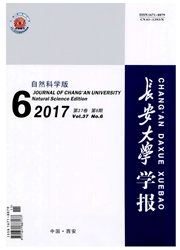

 中文摘要:
中文摘要:
交通运输业碳减排是中国碳减排中的核心重点之一。选取交通运输业消耗的12类能源,采用相应排放系数,测算1996~2010年中国交通运输业CO2排放,交通运输业CO2排放由1996年的195.41×106 t增加到2010年的505.73×106 t,基本与交通运输业的能源消耗量同步。采用情景预测分析法,设计基准情景、节能情景、低碳情景等3个情景,分别预测未来中国的碳排放量。分析结果显示,2011~2020年中国交通运输碳排放将呈快速上升趋势,而2025年左右将放缓。利用LYQ弹性脱钩分析进行交通运输业碳排放的脱钩分析。研究结果表明:产业减排在碳减排中的贡献度最大,而进入2006年之后,产业发展决定了交通运输业碳排放,2008年以后,产业节能的贡献程度最大,在抵消其他因素的影响之后使产业碳排放与GDP(国内生产总值)之间仍表现为弱脱钩,表明产业节能在中国交通运输业的碳减排中尤为重要。
 英文摘要:
英文摘要:
Carbon reduction in transportation sector is one of the core steps in China's carbon emission reduction.To begin with,12 kinds of energy consumed in transportation industry were selected to estimate carbon emissions in China's transportation industry from 1996 to 2010by use of the corresponding emission factor.The carbon dioxide emissions of transportation sector have increased from 195.41 megatons in 1996 to 505.73 megatons in 2010,which is basically in line with the growth of energy consumption in transportation industry.Then,by use of the scenario prediction analysis,China's future carbon emissions were predicted under three designed scenarios,namely,the baseline scenario,energy saving and low carbon scenarios.The analyses show that China's transportation carbon emissions will rise rapidly from 2011 to 2020,and then slow down around 2025.Moreover,the LYQ elastic decoupling analysis was utilized to make decoupling analysis of carbon emission of transportation.The results show that industrial emission re-duction contributes most to carbon emission reduction,and industry development determines the carbon emissions of transportation industry after 2006.However,industrial energy-saving has became the most influential part on carbon reduction since 2008.It still remained weak decoupling between the industry carbon emission and GDP after offsetting the impact of other factors,thus indicating that industrial energy-saving plays an extremely important part in carbon emission reduction of China's transportation industry.8tabs,1fig,16 refs.
 同期刊论文项目
同期刊论文项目
 同项目期刊论文
同项目期刊论文
 期刊信息
期刊信息
